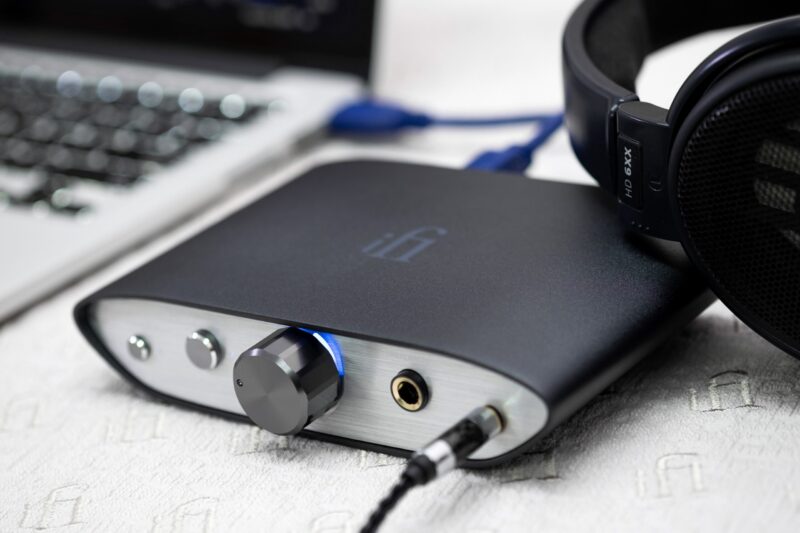When I reviewed iFi Audio’s original Zen DAC back in 2019, I couldn’t believe the massive value provided by the $130 desktop DAC Headphone Amp combo. It was compatible with all digital audio formats, including high-resolution formats like MQA and Native DSD, plus it had decent power, especially via the balanced output. Most importantly, it sounded pretty damn good.
Over the last couple of years, the Zen DAC has become the affordable centerpiece of many a headphone rig, and it’s held up pretty well. There still aren’t many devices that do what it does for the price.
That didn’t stop iFi from tweaking the product, and now we have the $159 Zen DAC V2 Headphone Amp/Dac.
So what’s the difference besides a small price increase?
The answer is, the new version has received some clever upgrades under the hood, giving it improved performance over the original.
If you’re looking for an inexpensive yet sophisticated way to both upgrade the sound coming from your digital sources (laptops and phones) and make your headphones sing, the Zen DAC V2 should be your first stop. Read on for more details!
Disclaimer: The iFi Zen DAC V2 has been provided to us on loan for this review. As of this writing, iFI Audio is a sponsor of Hifitrends, but all opinion in this review is solely our own, and no input has been given from the manufacturer.
Build/Features
At first glance, there isn’t much difference between the Zen DAC V1 and V2, but a closer look reveals a darker iFi logo on the top of the V2 and “Zen DAC V2” branding on the back.
Without turning them on, those are the only differences you’ll see.
However, upon feeding them an MQA signal, you’ll see the other difference. On the original version, you’ll see a Magenta indicator light on the front of the unit.
On the new version, MQA can be signified by either a Green or Blue LED on the front of the DAC, as well as Magenta, bringing to light (no pun intended) a sensational new feature.
That would be the Zen DAC V2’s ability to act as a full MQA decoder, as opposed to the V1, which was just an MQA “renderer.” That means the V2 doesn’t need a piece of software like TIDAL or Roon (a Core Decoder) to do the initial “unfold” of the MQA music file.
It can keep all the decoding in-house, applying DAC-specific compensation and management to the file. Because of this, the Zen DAC V2 can “authenticate” MQA tracks as “MQA Studio” (blue Light), which means the music represents the exact sound produced in the studio. This is called “Provenance” in MQA parlance.
If a track is fully decoded by the DAC but doesn’t have Provenance, it’s represented by a “green” light.
Here’s MQA’s explanation of Provenance:
-
The MQA ‘Studio’ (blue light) gives confirmation directly from mastering engineers, producers, or artists to their listeners. MQA Studio authenticates that the sound you are hearing is exactly as played in the studio when the music was completed and, by implication, that this is also the definitive version of the recording at that point in time.
-
A second level, ‘MQA’ (green light) is available to indicate that although the stream is genuine, provenance may be uncertain or that it is not yet the final release.
By the way, if you still decide to have a Core Decoder like TIDAL do the initial decode of the MQA file, then use the Zen DAC V2 as a renderer, you will get the same magenta light that was present on the original Zen DAC.
This MQA decoding capacity is made possible by a new 16x XMOS controller chip (the same one used in their excellent iDSD NEO DAC). This chip has double the clock speed of the original Zen DAC chip.
Besides a new processor, there’s also an upgraded crystal clock to reduce jitter and noise. Ifi says this will provide improved sonics over the original Zen DAC. This makes sense because lower noise and jitter mean less distortion of the music signal, which means you should get a cleaner signal overall.
Other than that, the two Zen DACs are basically the same. You get the same nice chassis, SE and Balanced connections, Truebass analog bass enhancement, and Power Match gain control.
Of course, you’ll also find some of the bugaboos we found with the V1, like the lack of a dedicated power supply (sold separately) and a slight channel imbalance at the beginning of the volume range, limiting the ability to listen at low volumes with sensitive headphones. I consider neither one a dealbreaker, but it’s worth mentioning.
Since the core functionality of the Zen DAC V2 is pretty much the same as the original, I won’t do a full breakdown here. You can read my original Zen DAC review for that.
So when you talk about the Zen DAC V1 vs. V2, it mainly comes down to sound quality. Is the Zen DAC V2 sound worth the extra $30 smackers? Well, let’s check it out!
A Zen DAC V1 vs. Zen DAC V2 Listening Comparison
For my comparison, I hooked up both the original Zen DAC and the Zen DAC V2 to my HP Envy X360 laptop. I played a wide variety of music via the TIDAL Desktop app, listening with a pair of Hifiman SUNDARA headphones connected to both 3.5mm single-ended output and the 4.4mm balanced output.
Via the Balanced out, the Zen DAC V2 had way more than enough power to drive these planar cans, producing a nice listening volume at about a quarter-turn of the knob.
I made many A-B-A comparisons between the two, and as you would suspect, the two DACs sounded quite similar, whether listening to MQA or Non-MQA streams.
Both provided a somewhat warm sound with nice detail throughout the treble and midrange. Tonal balance is excellent on both. There’s really no part of the audioband that’s given undue attention, so they both get out of the way and let your headphones do their thing.
However, if you want, you can press the True Bass button on either Zen DAC, and they will add a little bit of extra warmth via a tasteful sub-bass boost. It’s nice if you feel your headphones are a little too flat.
That said, the Zen DAC V2’s sound was also just a little more refined than the original. The background was definitely a little blacker, which allowed me to hear more detail at lower volumes than on the V1 model. Vocals were more fleshed out, and micro-detail on strings and other instruments was more pronounced on the V2.
There was also more separation between elements in the mix. When I listened to “Teach You” from Emily King’s “Sides” album, (a non-MQA track) there’s a part where Emily King and Sara Bareilles sing together. On the V1, the two vocals seemed more homogenized, sounding more like one vocal, which takes away from the beauty of the song.
On the V2, you could better hear the individual vocals and how they blended, making the song a lot more engaging.
A distinct improvement could also be heard on MQA Studio songs like “Birds” by Dominique Fils-Aimé. When I listened to it on the Zen DAC V2 (with the Blue Light on) vs the original Zen DAC (Magenta Light), the track was a lot more vivid on the V2. The vocal was very natural and alive, plus the upright bass plucks just had more body.
Of course, the degree of difference you hear will be dependent on how resolving your headphones are. For example, the difference in sound was more apparent with the Hifiman SUNDARA ($349) and Grado Hemp ($420) than it was with the less resolving Massdrop x Sennheiser HD 58X Jubilee headphone ($170) (Get a $10 Drop Credit Here).
The bottom line is: no matter what music I listened to, it had just a little more detail and depth when I listened to it on the Zen DAC V2 versus the V1.
The Wrap Up
While I loved the sound of the original, the sonic improvements in the Zen DAC V2 are well worth the additional $30 bucks. iFi did a great job of adding a bit more sophistication to the sound while still keeping the price low. Also, if you’re an MQA fan, the full MQA decoder will give you the best sound the format has to offer. Add to that the excellent features and power brought over from the Zen DAC V1, and you once again have the desktop DAC/Amp to beat around $150.
If you’re looking for a great-sounding desktop rig that won’t break the bank, it will be hard to beat the Zen DAC V2/Hifiman SUNDARA combo for around $500.
Hifitrends is reader-supported. When you purchase through links on our site, we may earn an affiliate commission. Prices are subject to change at any time.

I’m an audio writer who started as a young audio salesman/consumer electronics professional back in the late 90s. That’s where I discovered the magic of 2-Channel sound. My hunger for great sound has led me on a delightful music quest that continues today.







Leave a Reply